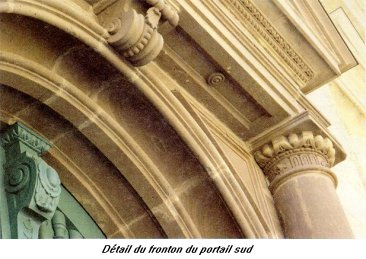From 1601 to 1607, the Saint Martin
building site is supervised by Heinrich Schickhardt: the interior
fittings continue from 1609 to 1615 and the building of the wooden
bell tower in 1677 puts an end to the construction of the church.
The foundation work starts on January
14th 1601. The first stone is laid on March 5th
1601: a copper plate is put in the stone with some coins and a list
of the authorities of the time.
On May 4th, sixteen people
work on the site.
The construction needs 21,223 carved or
sculpted stones, bound with lime, sand or lead.
These stones come from some quarries,
quite far away from Montbéliard.
Ten kilometres from there, the quarry
of Vandoncourt supplies the «white stone» or wall limestone: the
sandstone «of the Vosges» or «red stone» of the great doors and
of the pilasters basis is extracted from the quarries in the Haute
Saône – Chagey and Champey.
The greyish sandstone which makes up
the window framework comes from another quarry in Chagey.
The stone is flaked by the masons
before being carried to the church site.
The masons are still working there when
a carpenter from Stutgart is required in 1602 to make 500 roofing
timbers.
The fir tree woods bought in the
surroundings of Porrentruy are delivered in 1604.
The timber is brought up between 4th
and 22nd August 1604. The roof is made up of 59,456 tiles
from the Montbéliard and Héricourt tileries.
After the shell of the building at the
end of 1605, the works are completed on September 15th
1607.
The construction of the evengelical
church will have lasted six years and nine months.
Its dedication takes place on October
18th 1607. In 1615, the timber is reinforced, ten dormer
windows are opened, the tile roofing is mended, some caves are built
over the cornice front of the West façade.
The building materials such as iron,
nails, boards and lime come from the Bart ironworks, the Vandoncourt
nail factory and the Bart lime kiln.
The principality funds provide half of
the building cost, estimated at 25,636 «francs forts», Stuttgart
finances provide 14.6% and the rest is given by patrons and
subscribers such as senior civil servants.

